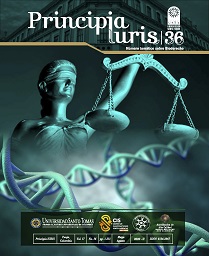Biodroit, science et technologie
##plugins.themes.bootstrap3.article.main##
Résumé
##plugins.themes.bootstrap3.article.details##
Por medio de esta comunicación certifico que el artículo que estoy presentando para posible publicación en la revista institucional impulsada de la Facultad de Derecho de la Universidad Santo Tomás seccional Tunja, Principia Iuris, es de mi entera autoría, siendo sus contenidos producto de mi directa contribución intelectual.
Todos los datos y referencias a publicaciones hechas están debidamente identificados con su respectiva nota bibliográfica y en las citas que se destacan como tal.
Por todo lo anterior, declaro que el material presentado se encuentra conforme a la legislación aplicable en materia de propiedad intelectual, y por lo tanto, me hago responsable de cualquier reclamación relacionada a esta.
En caso de que el artículo presentado sea publicado, manifiesto que cedo plenamente a la Universidad Santo Tomás seccional Tunja los derechos de reproducción del mismo y accedo a las modificaciones que de forma se requieran para adaptarse a la estética de la revista. Como contraprestación de la presente cesión, declaro mi conformidad de recibir (2) ejemplares del número de la revista en que aparezca mi artículo.
Références
Bernstein, G. (2007). Toward a General Theory on Law and Tęchnology: Introduction, Minnesota Journal of Law, Science & Technology, 8, 441-447.
Calo, R. (2015). Robotics and the Lessons of Cyberlaw. California Law Review, 103, 513-531.
Franssen, M., Lokhorst, G.J. & van de Poel, I. (2010). Philosophy of Technology. In, E.N.Zalta (Ed.), The Stanford Encyclopedia of Philosophy. http://plato.stanford.edu/archives/spr2010/entries/technology/Accessed 26 Mar 2018.
Glannon, W. (2007). Defining Right and Wrong in Brain Science. Essential Readings in Neuroethics. New York: Dana Press.
Goodenough, O.R. & Tucker, M. (2010). Law and Cognitive Neuroscience, Annual Review of Law and Social Science, 6, 61-92.
Hobbes, T. (1982). Leviathan. Fourth idition, London: Penguin Classics.
Keisen, 11. (1945). General 'iheor y of Law and State. Cambridge MA: Harvard University Press.
Knoppers, B.M. & Saginur, M. (2005) The Babel of Genetic Data Terminology. Nature Biotechnology, 23(8), 925-929.
Kolber, A.J. (2011). The Experiential Future of the Law. Emory Law Journal, 60, 585-652
Lunshof, J.E., Chadwick, R., Vorhaus, D.B. & Church, G.M. (2008). From Genetic Privacy to Open Consent. Nature Review Genetics, 9, 406-411.
Mills, J.S. (2013). On Liberty. Bath: Paragon Books.
Nordmann, A. (2004). Converging Technologies - Shaping theFuture of European Societies. HLEG Foresighting the New Technology Wave, European Commission Report.
Pollack, J.B. (2014). Mindless Intelligence: Reflections on the future of AI. In, P.A. Vargas, E.A. Di Paolo, I. Harvey & P. Husbands (Eds.), The Horizons of Evolutionary Robotics (pp. 279-294). Cambridge MA: MIT Press.
Roco, M.C. & Bainbridge, W.S. (Eds.). (2002). Converging Technologies for Improving Human Performance. Nanotechnology,
Biotechnology, Information Technologyand Cognitive Science. Arlington VA: National Science Foundation.
Santosuosso, A. (1987). I tuoi diritti. Milano: Hoepli.
Santosuosso, A. (1996). Diritti dei pazienti e doveri dei medici ne caso dell'eutanasia. In, C. Viafora (Ed.). Quando morire? Bioetica e diritto nel dibattito sull'eutanasia (pp. 207- 244). Padova: Fondazione Lanza-Gregoriana Libreria editrice.
Santosuosso, A. (2001). Corpo e libertà. Una storia tra diritto e scienza. Milano: Raffaello Cortina.
Santosuosso, A. (2002). Persones fisiche e confini biologici: chi determina chi. Politica del diritto, 3, 525-547.
Santosuosso, A. (2013b). Should Privacy be Abolished in Genetics an Biobanking? In, G, Pascuzzi G., U. Izzo U. & M. Macilotti (Eds.). Comparative Issues in the Governance of Research Biobanks. Property, Privacy Intellectual Property and Role of Technology (pp. 105-130). Berlin Springer.
Santosuosso, A. (Ed.). (2009). Le neuroscienze e il diritto. Como-Pavia: Ibis.
Santosuosso, A. & Bottalico, B. (2009). Neuroscinece, accountability and individual boundairs Front. Hum. Neurosci., 3, 45.
Santosuosso, A. Sellaroli, V. & Pavone, I. (2007). Drawing the Boundary Lines of Humans, Derecho y Religión, 2, 11-36.
Santosuosso, A., & G.C. Turri (2006). La trincea dell'inammissibilita, dopo tredici anni di stato vetetativo permanente di Eluan Englaro. La Nuova Giurisprudenza Civile Commentata, 1, 477-485.
Santosuosso, A. & Tamburini, M. (Eds). (1999). Malati di rischio. Implicazione etiche, legali e psicosociali dei teste genetici in oncologia. Milano: Masson.
Searle, J. (1969). Speeech Acts. Cambridge: Cambridge University Press.
Searle, J. (1995). The Construction of Social Reality. New York: Free Press.
Spohrer, J. (2002). Convergence to Improve Human Performance: Opportunities and Challenges. In, M.C. Roco & W.S. Bainbridge (Eds.), Converging Technologies for Improving Human Perfomance. Nanotechnology, Biotechnology, Information Technology and Cognitive Science (pp. 101-116). Arlington VA: National Science Foundation.

